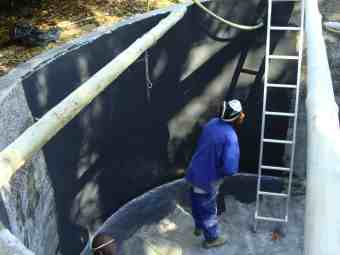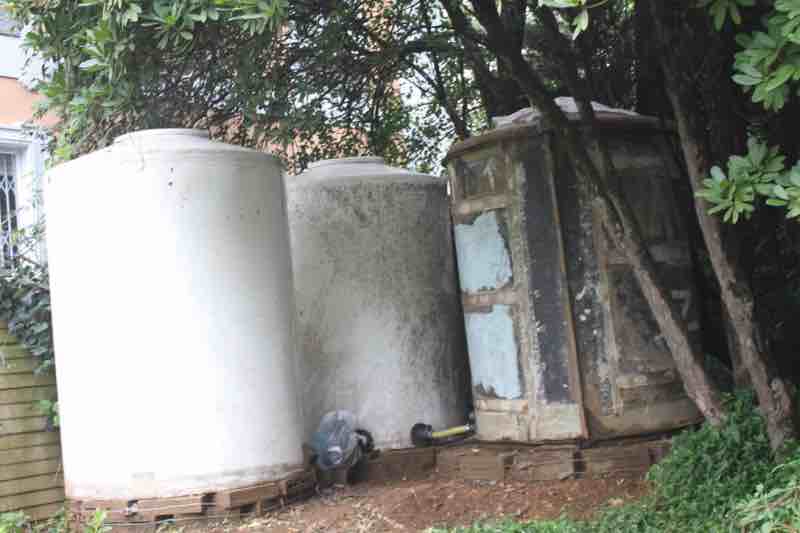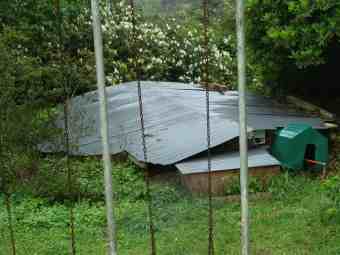- Bernard Preston homepage
- Our green rainwater
- Harvesting Rainwater
Harvesting rainwater
Harvesting rainwater for your home means escaping from the microplastics, remnants of medication and even artificial-sweeteners which proliferate in both that from the utility reticulation and bottles.
We do not actually use water; it simply passes through our homes, bodies and gardens on its way to a dam; and eventually back to the ocean via a river. Some of course evaporates.
More than enough lands on the roof of every home in an average month during the rainy-season to supply all of our needs for the whole year.
Storing the water

Like the free electrical energy landing on our rooves, the main problem is storage; you have to be able to save enough rainwater for the long dry-months.
More sensible is not to go off the municipal supply completely but store enough for perhaps a couple-months.
In 2016 for half a year in the KZN Midlands, for example we had only 60mm of rain but that was very exceptional. El Nino, warming in the Pacific Ocean took the blame.
Thankfully the summer rainfall-pattern will return and there should be more than enough; if you can store it.
Harvesting rainwater
The average home might use about 20 kilolitres per month; storage of 40kl is the problem. That is enough for a small swimming-pool.
In the end some compromise is necessary; we settled for 25kl; it is enough for the average dry winter and has proved adequate. For only two months in nine years have we had to use water from the utility; however there is usually a degree of range-anxiety by the end of that period.
How large should the reservoir be?
If I was to do it again I would make the reservoir two metres deep and 5m in diameter.
A 25mm storm on a 200 m2 roof would provide 0.025 x 200 = 5 kl.
Five such rains would fill our reservoir. Daily usage is considerably less than one kilolitre for 7 people and a large vegetable garden. In practice, it is difficult collecting the water from the gutters on the far side of the house; you might aim to harvest half of that falling on your home.
Digging trenches and plumbing a series of standard sewerage pipes to the reservoir proved very simple and inexpensive; one could add first-flush devices.
Your desire may be simply to go-green; to use what the heavens provide instead of relying on your utility to furnish all of your needs. It may be that you are increasingly concerned that for various reasons the authorities will in the future not be able to provide a continuous supply of unpolluted, potable water to your home.
"Sewage, industrial toxins and agricultural waste are polluting Gauteng’s rivers and dams, posing a greater crisis than the current water supply woes in the region."
- Times Live, October 2025
Contaminants in utility water
High on the list of water contaminants is asbestos from aging municipal-pipes; it causes a very serious bowel tumour called a mesothelioma when drunk.
Whether it is E. Coli, other pathogens or simply no water at all, many South African towns have serious problems with both the provision and quality of the reticulation.
Acid ground-water in mining areas and the products formed from the action of chlorine on organic matter are serious problems too.
The auditor-general reports that the Department of Water and Sanitation is in crisis; it is not going to get better in the immediate future. If you want to be independent of these woes of the new South Africa then it is time to start planning. And of course, the expense is offset by the increasing cost of municipal utilities.
"Water restrictions are expected to be rolled out in six of the eight metros in the coming five years."
- Daily Maverick, August 2022
Contaminants in rainwater
Storage means use of either polyethylene or fiberglass tanks; the latter last forever but cost a bit more. Both have the disadvantage of being unsightly and above ground, any pathogens will flourish in the warm water.
There are also increasing concerns about plastic microparticles in rainwater. Those that are small enough can cross the blood-brain barrier causing dementia and a host of other problems.
Additionally we chose to build a large underground reservoir, two metres deep and four in diameter; with a corrugated iron roof to keep the light out. A pump provides our home and garden with plentiful, high-pressure water.

The total cost for the reservoir was about R20,000; the three tanks a bit more. Payback time turned out to be six years, excluding all the health-issues associated with polluted water; and the periodic frustration of empty taps.
Plastered correctly the reservoir should not leak but ours did; that meant fiber-glassing the whole, an extra cost of R15,000. Now we have zero losses; and in the summer the water level rarely drops more than a few centimetres.
Between the idea
And the reality
Between the motion
And the act
Falls the Shadow.
TS Eliot: The Hollow men
I drink the water without reservation despite the Hadedas that frequent our roof; and have not had the slightest problem. You could install an ultraviolet light or ozone it.
More difficult are the leaves that trees deposit on the roof. Keeping the gutters clean is a maintenance issue but should be done anyway.
Going green is not without difficulties; harvesting and storing the rain is no different. In the short term there is a considerable expense; in the longer period having high-quality, soft and clean water, free of chlorine in your home is without measure.
Enjoying a generous fifteen-minute hot shower, knowing you are not taxing the planet in any way simply adds to the pleasure and relaxation.
Post chlorination is a very significant issue that needs to be faced by those concerned about their well-being. Any organic matter in municipal water makes it decidedly dangerous.
To heck with water-saving devices and energy efficient showers is our cry. A solar generator easily drives the electric pump that supplies the home with the pristine stuff.
To see how it is done, follow this link to a rainwater harvesting model.

Synergy of green living
There is a wonderful synergy of green living. The heavens provide water and electricity that supply the home with reliable, pristine utilities at zero cost. There is no longer any anxiety associated with load-shedding or inaccurate accounts from the inept municipality.
The water supplies our home and the garden which provides wonderful organic-food. Busy on our 78th orbit of the sun, neither of us have any health issues whatsoever; we take no drugs. We are busy this summer harvesting half a ton of new potatoes from an ordinary suburban garden.
What is not ordinary is two very energetic elderly gardeners who are not afraid of hard work; who love to cook and are not anxious about new dishes.
We were not forced to drop our medical insurance; we chose to do it and have saved a mint. That too has spurred us on to greater efforts to live according to our cyan zone principles.
There is no shadow between the idea and the reality at our green home; we are in effect totally off the grid. But we are toying with a dedicated mains electricity line to power our maizemeal mill; the inrush current from the 3kW motor is stressing the inverter.
It's done; with the help of a "D-curve" breaker.
Lessons from the island of Bermuda
We could take a tip from Bermuda which has a surface-area of 53 km2, roughly double the size of the village where we live. The island has no rivers, streams or lakes; harvesting rainwater is their only option.
80pc of the roof area of all homes must be guttered by law; and for every square-metre the owner shall have a reservoir of capacity 80 gallons, or 270 litres[1].
So a home with a roof of 100 m2 shall by law have a reservoir with a capacity of 24 kl, roughly the same as ours above; we should all be harvesting rainwater.
Electricity or water?
For the more affluent no choice need be made; they can have their cake and eat it. But for the very poor, difficult decisions have to be made.
Bhorat et al found that after 20 years of freedom, for the poor access to electricity for lighting had increased by 55%; but to water by only 14 percentage points[2]. Since harvesting the rain costs a fraction of collecting sunshine, it would be prudent for the state to spend more money on underground reservoirs and tanks for the indigent than extra power.
Thirty years into freedom from Apartheid, the new regime has brought running water to only 1% of the population of a vast rural area of KZN known as Impendle; nothing has changed.
"The 2023 Blue Drop Report found that 46% of all supply systems around the country posed acute human health risks because of bacteria or other pathogens in the drinking water."
- Times Live, October, 2025
Harvesting rainwater
After harvesting rainwater it is best stored underground where it is kept very cold and less prone to bacterial-contamination.
When browsing use right click and "Open Link in New Tab" or you may get a bad gateway signal.
Newsletter
Our newsletter is entitled "create a cyan zone" at your home, preserving both yourself and Mother Earth for future generations; and the family too, of course. We promise not to spam you with daily emails promoting various products. You may get an occasional nudge to buy one of my books.
Here are the back issues.
- Lifestyle and ideal body weight
- What are ultra-processed foods?
- Investing in long-term health
- Diseases from plastic exposure
- Intensive lifestyle management for obesity has limited value
- A world largely devoid of Parkinson's Disease
- The impact of friendly bacteria in the tum on the prevention of cancer
- There's a hole in the bucket
- Everyone is talking about weight loss drugs
- Pull the sweet tooth
- If you suffer from heartburn plant a susu
- Refined maize meal and stunting
- Should agriculture and industry get priority for water and electricity?
- Nature is calling
- Mill your own flour
- Bake your own sourdough bread
- Microplastics from our water
- Alternative types of water storage
- Wear your clothes out
- Comfort foods
- Create a bee-friendly environment
- Go to bed slightly hungry
- Keep bees
- Blue zone folk are religious
- Reduce plastic waste
- Family is important
- What can go in compost?
- Grow broad beans for longevity
- Harvest and store sunshine
- Blue zone exercise
- Harvest and store your rainwater
- Create a cyan zone at your home
Did you find this page interesting? How about forwarding it to a friendly book or food junkie? Better still, a social media tick would help.
- Bernard Preston homepage
- Our green rainwater
- Harvesting Rainwater
Address:
56 Groenekloof Rd,
Hilton, KZN
South Africa
Website:
https://www.bernard-preston.com